Abecedarian Big Chess (ABChess)
Design-your-own chess armies on a big board
by Glenn Overby
It's All In The Name...Abecedarian, of or pertaining to the alphabet. There are 26 different pieces (but all are not used in a given game), one for each letter from A to Z. Big, of great size, power, or amount. With 121 squares instead of 64, 44 pieces on board instead of 32, and 26 piece types instead of 6, this is big. Chess, a boardgame played by two players where the object is to capture the opponent's king, or trap it so it cannot avoid capture. What's It All About?For more than a thousand years chess players have experimented with adding different pieces to the game. Often the board was enlarged to let new pieces coexist with the old. In recent years, there have also been several attempts to permit players to pick balanced teams within certain limits, so the forces and setups are not necessarily identical. Some of these have been inspired by modern wargames, and several proven designers have attacked the project. Abecedarian Big Chess, or ABChess, does all of this. Twenty possible pieces are added to the six we know in orthodox chess. Nineteen of those 20 pieces have been used before, often with a history from 50 to several hundred years. The familiar King and hybrid Pawn (newly christened Yeoman) acquire some features of their Oriental counterparts. The ABChess board is larger, to permit more of these pieces to come into play for each side. The point values given to each piece reflect the larger board. Much has changed in ABChess. But the game is, at its heart, still chess. The object is still checkmate. Pieces step, ride, and leap. They (almost always) land on the foe's space to capture. ABChess provides variety...there are millions of setups. A system of rote openings is not possible. Creativity is valued. New tactical principles are ripe for discovery. Yet the things that give chess its enduring popularity are not sacrificed. Many of the new pieces use venerable ideas in new ways. The fortresses and river, familiar in other parts of the world, are exotic in the West and fundamentally change (and speed up) the endgame. |
Setup
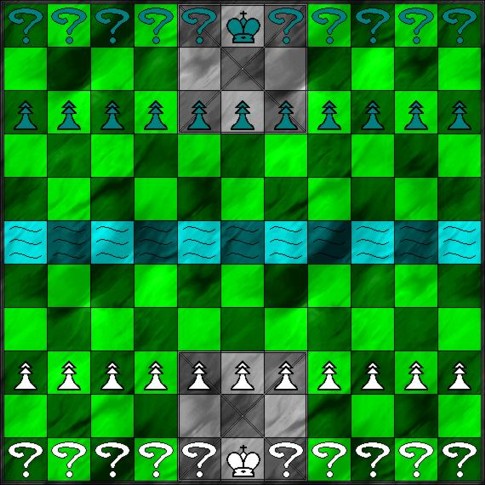
Each side starts with one King and 11 Yeomen as pictured.
Each side also buys 10 more pieces, set up in the ? spaces.
The board is 11 by 11 squares. On each player's side of the board, the center 3X3 square area at that player's edge is their fortress. Fortresses affect the moves of the King and Teleporter. The middle rank of the board is the river. Crossing the river gives Yeomen increased movement, and allows them to promote.
Each player's King starts in the center of the player's back rank. Each player's Yeomen start across the player's third rank.
Pieces
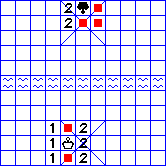 |
King: start with one The King may move one space in any direction. As in most forms of chess, the King may not move to a square that is attacked by an enemy, and must not be left in a position where it is being attacked by an enemy. ABChess borrows two limits on the King from Xiangqi. First, the King is restricted to the nine squares of his fortress. Second, the Kings may never face each other on the same file, with no pieces in between them. In the diagram, spaces marked 1 would be legal King moves but for the fortress rule. Spaces marked 2 would be legal King moves but for the rule about opposing Kings on a file with nothing between them. |
||
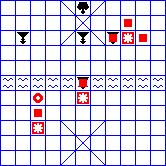 |
Yeoman: start with 11 (Center example) The Yeoman is a combination of traditional pawns. On its own side of the river, it moves one square forward (as in Xiangqi). This includes captures. (Left example) A Yeoman on its starting square may move two spaces forward instead of one, but only if both are vacant (as in orthodox chess). (Right example) A Yeoman which has crossed the river can move or capture one square sideways as well as forward (also as in Xiangqi). A Yeoman which moves to any space on the opponent's side of the river may, as part of that move, promote (similar to Shogi). A Yeoman may choose not to promote, but must move again in order to promote later. A Yeoman may promote to any piece already lost by its side this game. |
How Do I Build My Army?In addition to the King and 11 Yeomen, each player gets a customized army. There are four rules for building that army:
The 10 pieces bought by each player will start in the 10 vacant squares on that player's back rank. Each player should write down the pieces they are buying and their starting squares without first seeing the other's choices. As an alternative, players can alternate turns (White first) buying a piece and putting it on the board. Care must be taken to stay under the spending limit when playing this way. What Can I Buy?The 26 available pieces fall into nine groups:
List of Pieces by Price20 -- Varan |
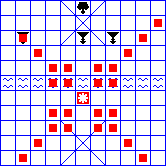 |
Archbishop: 12 points The Archbishop may move like a Bishop, sliding any clear distance along a diagonal, or like a Horse, with a (1,2) leap. When moving like a Horse the Archbishop ignores intervening pieces. |
||
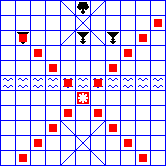 |
Bishop: 7 points The Bishop may slide any clear distance along a diagonal. It may not leap over any piece, or move onto a square occupied by a friendly piece. |
||
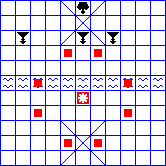 |
Camel: 4 points The Camel moves one square horizontally or vertically, turns 90 degrees, and continues three squares; or the opposite (three squares, turn, one square). In either case it ignores intervening pieces and leaps from square to square. |
||
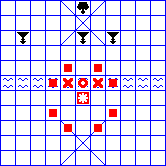 |
Dragon: 6 points The Dragon may move like a Horse, with a (1,2) leap. It may also move like an orthodox chess pawn, one square straight forward to an empty square or one square diagonally forward to a square occupied by an enemy. The Dragon does not share the orthodox pawn's two-square forward movement from its starting position. |
||
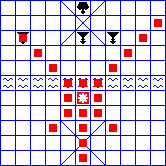 |
Eagle: 10 points The Eagle moves forward diagonally like a Bishop, sliding any clear distance. It moves vertically backward like a Rook, sliding any clear distance. It moves straight forward or sideways one square. Finally, it moves diagonally backward one or two squares (but does not leap to do so). |
||
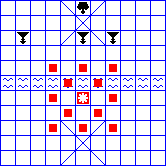 |
Fad: 8 points The Fad may move one square diagonally, or leap two squares diagonally, or leap two squares horizontally or vertically. The two-space moves ignore intervening pieces. Note that a Fad, like a Bishop or Camel, is bound to squares of one color. The Fad's move combines the classic moves of the Ferz, Alfil, and Dabbabah, whence the name. |
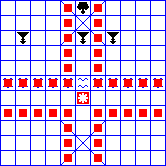 |
Gryphon: 19 points The Gryphon moves one space diagonally, and may then continue outward either horizontally or vertically any number of unobstructed spaces. The Gryphon cannot leap over other pieces, and must start its move with the one diagonal space. |
||
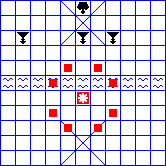 |
Horse: 5 points The Horse moves one square horizontally or vertically, turns 90 degrees, and continues two squares; or the opposite (two squares, turn, one square). In either case it ignores intervening pieces and leaps from square to square. |
||
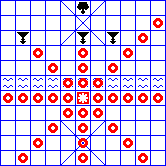 |
Immobilizer: 18 points The Immobilizer moves like a Queen, sliding any distance in any direction. An Immobilizer cannot capture. However, it freezes adjacent enemies. Any piece adjacent to an enemy Immobilizer (including diagonally) cannot move. |
||
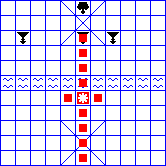 |
Jugyo: 6 points The Jugyo, or vertical mover, may slide any clear distance vertically like a Rook. It may instead move one space horizontally. |
||
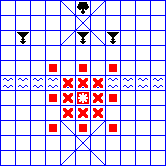 |
Lion: 7 points The Lion may leap exactly two squares in any of the eight directions, ignoring intervening pieces. Two-square moves may or may not capture. The Lion may also move one space in any direction like a King, but only to capture. |
||
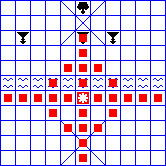 |
Marshal: 16 points The Marshal may move like a Rook, sliding any clear distance horizontally or vertically, or like a Horse, with a (1,2) leap. When moving like a Horse the Marshal ignores intervening pieces. |
 |
Nightrider: 9 points The Nightrider's move starts out identical to the Horse, a (1,2) leap. However, if the square in question is vacant the Nightrider may continue (1,2) leaps along the same line without limit, until the square which would be landed upon is not empty. It slides or rides along the line of squares a classic knight-move apart just like a Bishop or Rook slides along a traditional line. |
||
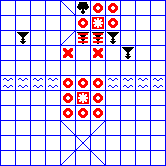 |
Overtaker: 3 points The Overtaker may make a non-capturing move of one space in any direction to an empty square. The Overtaker may capture an enemy piece, in any of the eight directions, by leaping over it to the next square beyond if that square is empty. |
||
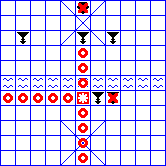 |
Pao: 10 points The Pao moves without capturing like a Rook, sliding any distance horizontally or vertically. To capture, a Pao moves like a Rook, leaps over exactly one piece of either color, and continues on that line to land on the next occupied space if and only if an enemy occupies it. The Pao may not capture without leaping over exactly one piece. The Pao may not leap over a piece without capturing. The piece captured is the piece landed upon, not the piece leaped over. |
||
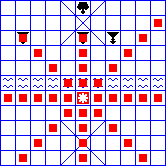 |
Queen: 17 points The Queen may move like a Bishop, sliding any clear distance along a diagonal, or like a Rook, sliding any clear distance horizontally or vertically. |
||
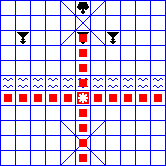 |
Rook: 11 points The Rook may slide any clear distance horizontally or vertically. It may not leap over any piece, or move onto a square occupied by a friendly piece. |
||
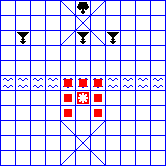 |
Suizo: 5 points The Suizo, or drunk elephant, may move one space in any direction except directly backward. It has seven possible moves in most positions. |
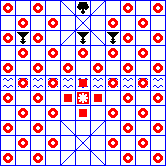 |
Teleporter: 14 points The Teleporter, when not capturing, may move to any light space when on a dark space, or any dark space when on a light space, outside the two fortresses. The Teleporter in ABChess may capture by moving one space horizontally or vertically to a space occupied by an opponent. This is the only way a Teleporter can occupy a fortress. |
||
 |
Unicorn: 16 points The Unicorn may move like a Bishop, sliding any clear distance along a diagonal, or like a Nightrider, in a line of successive (1,2) leaps provided that each leap save the last is to a vacant square. |
||
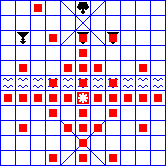 |
Varan: 20 points The Varan may move like a Rook, sliding any clear distance horizontally or vertically, or like a Nightrider, in a line of successive (1,2) leaps provided that each leap save the last is to a vacant square. |
||
 |
Wildebeest: 9 points The Wildebeest may move like a Horse with a (1,2) leap, or like a Camel with a (1,3) leap. It ignores intervening pieces. |
||
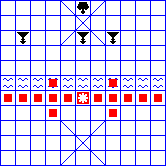 |
Xebec: 8 points The Xebec, a complement to the Jugyo, may slide any clear distance horizontally like a Rook. It may also move as a Horse, but specifically one space vertically followed by two spaces horizontally and not the opposite. The Xebec ignores intervening pieces when using its Horse-like moves. |
||
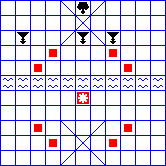 |
Zebra: 4 points The Zebra moves two squares horizontally or vertically, turns 90 degrees, and continues three squares; or the opposite (three squares, turn, two squares). In either case it ignores intervening pieces and leaps from square to square. |
Rules of PlayHere is a summary of key rules, in addition to the moves and setup of the new pieces.
A Collection of TipsDespite the much larger board, promotion is even more important here than in standard chess. The promotion zone is only three moves away, instead of five, and Yeomen do not form structures to block each other like orthodox pawns. The pieces with Nightrider powers, the Pao, and the Teleporter all have first-move surprise tactics available. Work them out for yourself...they are not hard...and watch for them in your setup choices. If the center Yeomen start to disappear, some interesting mate tactics can flow from the restriction on Kings facing each other. Also, an Immobilizer on the loose can freeze a King for dramatic mate potential. When buying colorbound pieces, the Bishop, Camel, and Fad, it's worth doing it in pairs. Computer Play with Zillions of GamesThe script for playing ABChess with the Zillions of Games program is under development. It will be available for download here when it is complete. AcknowledgementsThe ideas behind this game came from a wide range of sources. Below I list many of the inventors, chroniclers, popularizers, and advisors who made this game possible. It's necessarily an incomplete list, but still worth a try. Robert Abbott, King Alfonso X of Castile, Peter Aronson, Ralph Betza, Hans Bodlaender, J.R. Capablanca, T.R. Dawson, Christian Freeling, Roger Hare, David Howe, Adrian King, John Lawson, H.J.R. Murray, Ohashi Soei, David Pritchard, Tony Quintanilla, R. Wayne Schmittberger, David Short, and assorted Indians, Chinese, Japanese, and Persians whose imaginations live on. |
Written by Glenn Overby II.
WWW page created: November 5, 2002.
